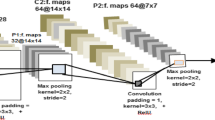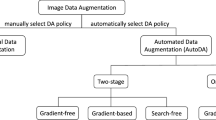Abstract
The improved algorithm for attribute combinatorial optimization based on the Minimum Weighted Random Search (MWRS) and “Equal-Sum” (E-S) judgment method is proposed to against that the recognition performance of the image recognition model trained by a specific dataset is significantly reduced after being transplanted. First, the MWRS algorithm is used to search the image attribute combination and the searched attribute combination is filtered through the E-S judgment method. Then, the image that being transformed by the selected attribute combination is input to the improved neural network. Finally, the Adam optimization algorithm is used to train the model. In this context, the Minimum Weighted Random Search Data Augmentation (MW-RSDA), the Minimum Weighted Evolution-Based Search Data Augmentation (MW-ESDA) and the Minimum Weighted Random and Evolution-Based Search Data Augmentation (MW-RESDA) were proposed. The experimental results show that the overall recognition accuracy is increased by at least 3.7% after the improved digits recognition model is transplanted. Moreover, the improved CIFAR-10 (a 10-class dataset named after Canadian Institute for Advanced Research) classification model increased the recognition accuracy by at least 5.8% on the testing dataset, which significantly improve the influence of domain shift to recognition model.









Similar content being viewed by others
Explore related subjects
Discover the latest articles and news from researchers in related subjects, suggested using machine learning.References
Adams N (2010) Dataset shift in machine learning. J R Stat Soc 173(1):274–274
Volpi R, Murino V (2019) Addressing model vulnerability to distributional shifts over image transformation sets. Proceedings of the IEEE International Conference on Computer Vision, pp 7980–7989
Blum A, Hardt M (2015) The ladder: A reliable leaderboard for machine learning competitions. In: International Conference on Machine Learning (ICML)
Torralba A, Efros AA (2011) Unbiased look at dataset bias. CVPR 2011. IEEE, pp 1521–1528
Szegedy C, Zaremba W, Sutskever I, Bruna J, Erhan D, Goodfellow I, Fergus R (2014) Intriguing properties of neural networks. In: International Conference on Learning Representations (ICLR)
Nguyen A, Yosinski J, Clune J (2015) Deep neural networks are easily fooled: High confidence predictions for unrecognizable images. 2015 IEEE Conference on Computer Vision and Pattern Recognition (CVPR), Boston
Papernot N, McDaniel P, Jha S, Fredrikson M, Celik ZB, Swami A (2016) The limitations of deep learning in adversarial settings. 2016 IEEE European Symposium on Security and Privacy (EuroS&P), Saarbrucken, pp 372–387
Carlini N (2017) Wagner d. Towards evaluating the robustness of neural networks. 2017 IEEE Symposium on Security and Privacy (SP), San Jose, pp 39–57
Moosavi-Dezfooli SM, Fawzi A, Frossard P (2016) Deepfool: A Simple and Accurate Method to Fool Deep Neural Networks. 2016 IEEE Conference on Computer Vision and Pattern Recognition (CVPR), Las Vegas, pp 2574–2582
Hosseini H, Poovendran R (2018) Semantic adversarial Examples. IEEE/CVF conference on computer vision and pattern recognition workshops (CVPRW), Salt Lake City, pp 1695–16955
Fawzi A, Fawzi O, Frossard P (2018) Analysis of classifiers robustness to adversarial perturbations. Mach Learn 107(3):481–508
Sokolić J, Giryes R, Sapiro G, Rodrigues MR (2017) Robust large margin deep neural networks. IEEE Trans Signal Process 65(16):4265–4280
Madry A, Makelov A, Schmidt L, Tsipras D, Vladu A (2018) Towards deep learning models resistant to adversarial attacks. ICLR 2018-Conference track proceedings. Vancouver:ICLR
Shaham U, Yamada Y, Negahban S (2018) Understanding adversarial training: Increasing local stability of supervised models through robust optimization. Neurocomputing 307:195–204
Mancini M, Bulo SR, Caputo B, Ricci E (2018) Robust place categorization with deep domain generalization. IEEE Robot Autom Lett 3(3):2093–2100
Sun B, coral Saenko K. (2016) Deep Correlation alignment for deep domain adaptation. European conference on computer vision. Springer, Cham, pp 443–450
Ghifary M, Kleijn WB, Zhang M, Balduzzi D, Li W (2016) Deep reconstruction-classification networks for unsupervised domain adaptation. European Conference on Computer Vision. Springer, Cham, pp 597–613
Tzeng E, Hoffman J, Saenko K, Darrell T (2017) Adversarial discriminative domain adaptation. 2017 IEEE conference on computer vision and pattern recognition (CVPR), Honolulu, pp 2962–2971
Volpi R, Morerio P, Savarese S, Murino V (2018) Adversarial feature augmentation for unsupervised domain adaptation. Proceedings of the IEEE Conference on Computer Vision and Pattern Recognition, pp 5495–5504
Motiian S, Piccirilli M, Adjeroh DA, Doretto G (2017) Unified deep supervised domain adaptation and generalization. Proceedings of the IEEE International Conference on Computer Vision, pp 5715–5725
Duan L, Tsang IW, Xu D (2012) Domain transfer multiple kernel learning. IEEE Trans Pattern Anal Mach Intell 34(3):465– 479
Li W, Duan L, Xu D, Tsang IW (2013) Learning with augmented features for supervised and semi-supervised heterogeneous domain adaptation. IEEE Trans Pattern Anal Mach Intell 36(6):1134–1148
Li H, Pan SJ, Wang S, Kot AC (2018) Domain generalization with adversarial feature learning. Proceedings of the IEEE Conference on Computer Vision and Pattern Recognition, pp 5400–5409
Li D, Yang Y, Song Y Z, Hospedales T M (2018) Learning to generalize: Meta-learning for domain generalization. Proc AAAI Conf Artif Intell 32(1)
Ghifary M, Balduzzi D, Kleijn WB, Zhang M (2016) Scatter component analysis: a unified framework for domain adaptation and domain generalization. IEEE Trans Pattern Anal Mach Intell 39(7):1414–1430
Niu L, Li W, Xu D, Cai J (2016) An exemplar-based multi-view domain generalization framework for visual recognition. IEEE Trans Neural Netw Learn Syst 29(2):259–272
Gan C, Yang T, Gong B (2016) Learning attributes equals multi-source domain generalization. Proceedings of the IEEE conference on computer vision and pattern recognition, pp 87–97
LeCun Y, Boser B, Denker JS, Henderson D, Howard RE, Hubbard W, Jackel LD (1989) Backpropagation applied to handwritten zip code recognition. Neural Comput 1(4):541–551
Mitchell M (1998) An introduction to genetic algorithms. MIT press
Chen W, Hao YF (2018) Genetic algorithm-based design and simulation of manufacturing flow shop scheduling. Int J Simul Modell 17(4):702–711
Wang Y, Yang O (2017) Research on industrial assembly line balancing optimization based on genetic algorithm and Witness simulation. Int J Simul Modell 16(2):334–342
Li HY, Gui C, Xiao K (2018) Simulation of multivariate scheduling optimization for open production line based on improved genetic algorithm. Int J Simul Model 17(2):347–358
LeCun Y, Bottou L, Bengio Y, Haffner P (1998) Gradient-based learning applied to document recognition. Proc IEEE 86(11):2278–2324
Netzer Y, Wang T, Coates A, Bissacco A, Wu B, Ng AY Reading digits in natural images with unsupervised feature learning. NIPS workshop on deep learning and unsupervised feature learning, Granada
Ganin Y, Lempitsky V (2015) Unsupervised domain adaptation by backpropagation. International conference on machine learning. PMLR, pp 1180–1189
Hull JJ (1994) A database for handwritten text recognition research. IEEE Trans Pattern Anal Mach Intell 16(5):550–554
Qiao F, Zhao L, Peng X (2020) Learning to learn single domain generalization. Proceedings of the IEEE/CVF Conference on Computer Vision and Pattern Recognition, pp 12556–12565
Carlucci FM, D’Innocente A, Bucci S, Caputo B, Tommasi T (2019) Domain generalization by solving jigsaw puzzles. Proceedings of the IEEE Conference on Computer Vision and Pattern Recognition, pp 2229–2238
Volpi R, Namkoong H, Sener O, Duchi J, Murino V, Savarese S (2018) Generalizing to unseen domains via adversarial data augmentation. Adv Neural Inf Process Syst:5334–5344
Krizhevsky A, Hinton G (2009) Learning multiple layers of features from tiny images. Masters thesis. Department of Computer Science University of Toronto
Coates A, Ng A, Lee H (2011) An analysis of single-layer networks in unsupervised feature learning. Proceedings of the fourteenth international conference on artificial intelligence and statistics. JMLR Workshop and Conference Proceedings, pp 215–223
Hendrycks D, Dietterich T (2019) Benchmarking neural network robustness to common corruptions and perturbations. ICLR
Zagoruyko S, Komodakis N (2016) Wide residual networks. In: BMVC
Xu X, Zhou X, Venkatesan R, Swaminathan G, Majumder ODS (2019) D-sne: Domain adaptation using stochastic neighborhood embedding. Proceedings of the IEEE/CVF Conference on Computer Vision and Pattern Recognition, pp 2497–2506
Motiian S, Piccirilli M, Adjeroh DA, Doretto G (2017) Unified deep supervised domain adaptation and generalization. Proceedings of the IEEE international conference on computer vision, pp 5715–5725
Author information
Authors and Affiliations
Corresponding author
Ethics declarations
Conflict of Interests
The authors declare there is no conflicts of interest regarding the publication of this paper. We declare that we do not have any commercial or associative interest that represents a conflict of interest in connection with the work submitted.
Additional information
Publisher’s note
Springer Nature remains neutral with regard to jurisdictional claims in published maps and institutional affiliations.
Rights and permissions
About this article
Cite this article
Tan, Z., Liu, X. ConvNet combined with minimum weighted random search algorithm for improving the domain shift problem of image recognition model. Appl Intell 52, 6889–6904 (2022). https://doi.org/10.1007/s10489-021-02767-8
Accepted:
Published:
Issue Date:
DOI: https://doi.org/10.1007/s10489-021-02767-8




